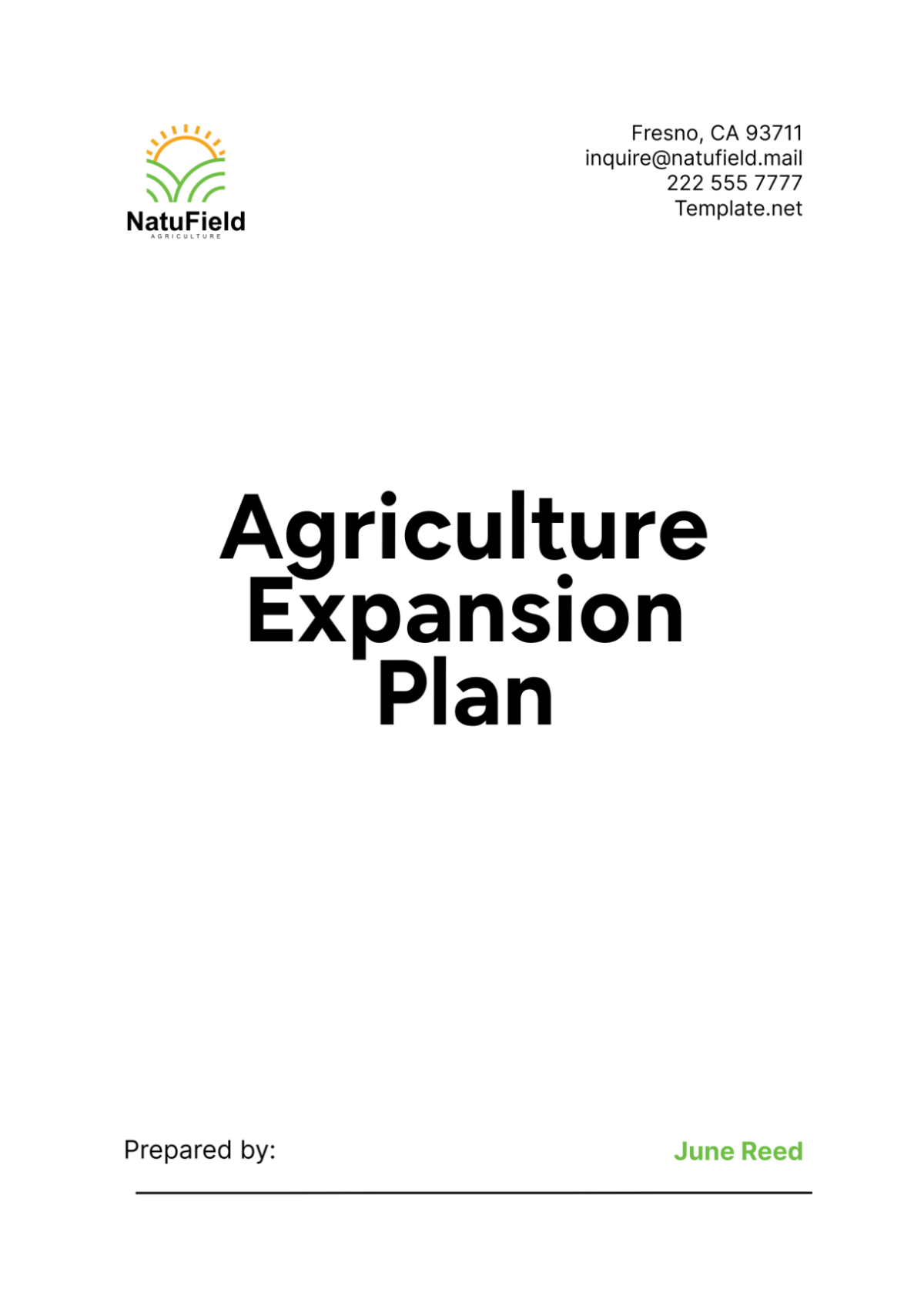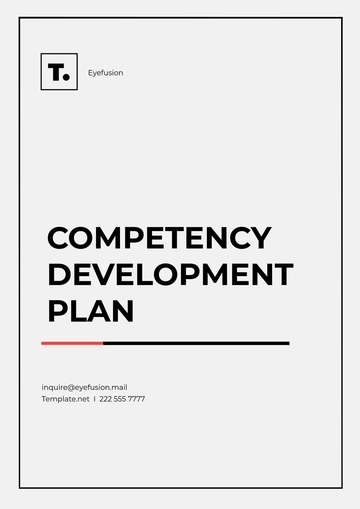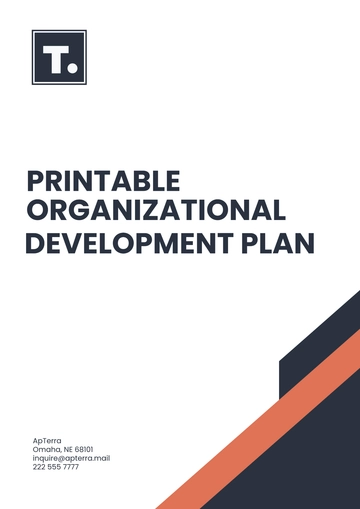Free Agriculture Expansion Plan

I. Executive Summary
A. Overview of the Agriculture Expansion Plan
[Your Company Name] aims to expand its agricultural operations to capitalize on emerging market opportunities and enhance production capacity. This expansion plan outlines a comprehensive strategy to achieve sustainable growth and profitability in the agricultural sector.
B. Objectives and Goals
The primary objectives of the expansion include:
Increasing annual crop production by 30% within the next three years.
Diversifying product offerings to include high-value crops such as organic vegetables and specialty fruits.
Expanding market reach to neighboring regions and establishing partnerships with local distributors.
C. Key Strategies and Actions
To achieve these objectives, [Your Company Name] will focus on:
Investing in modern irrigation systems to optimize water usage.
Enhancing soil fertility through organic farming practices.
Adopting precision agriculture techniques for efficient resource management.
Implementing robust quality control measures to ensure product consistency and customer satisfaction.
II. Current Agricultural Operations
A. Description of Current Agricultural Activities
[Your Company Name] currently operates on 500 acres of arable land, primarily cultivating staple crops such as maize, wheat, and soybeans. The operations are supported by a workforce of 50 skilled farm workers and technicians.
B. Analysis of Existing Resources and Infrastructure
Table 1: Existing Resources and Infrastructure
Resource/Infrastructure | Description |
|---|---|
Arable Land | 500 acres of fertile soil suitable for crop cultivation |
Machinery and Equipment | Tractors, harvesters, irrigation systems |
Facilities | Warehouses, storage facilities |
Human Resources | Skilled farm workers and agricultural technicians |
C. Review of Current Production Levels and Market Performance
[Your Company Name]'s current annual production stands at:
2,000 tons of maize
1,500 tons of wheat
1,000 tons of soybeans
Market Performance:
Supply contracts with local wholesalers and food processing companies.
Annual revenue of $2.5 million from agricultural sales.
III. Market Analysis
A. Overview of the Agricultural Market
The agricultural sector in the region is characterized by:
Growing demand for organic and specialty crops due to increasing health awareness among consumers.
Favorable government policies supporting agricultural development and investment.
Seasonal fluctuations in market prices are influenced by weather conditions and global market trends.
B. Identification of Target Markets and Customer Segments
Table 2: Target Markets and Customer Segments
Market Segment | Characteristics | Potential Demand |
|---|---|---|
Local Retail Consumers | Prefer locally grown organic produce | High, stable demand |
Food Processing Companies | Demand for bulk quantities of staple crops for processing | Stable demand, volume-driven |
Export Markets | Overseas markets for specialty crops | Emerging demand, premium pricing opportunities |
C. Analysis of Market Trends and Demands
Key market trends include:
Shift towards sustainable farming practices and organic products.
Increasing consumer preference for locally sourced food products.
Growing demand for non-GMO and pesticide-free crops.
D. Competitive Analysis
[Your Company Name] faces competition from:
Established local farms with extensive distribution networks.
Imported agricultural products offering competitive pricing.
Niche organic farms targeting high-income urban consumers.
IV. Expansion Goals and Objectives
A. Short-Term Expansion Goals
Increase crop yield by 20% in the first year through improved irrigation and fertilization practices.
Launch a pilot program for organic farming on 50 acres to test market acceptance and profitability.
B. Long-Term Expansion Goals
Achieve self-sufficiency in organic produce production within five years.
Expand market reach to neighboring countries through strategic partnerships and export agreements.
C. Key Performance Indicators (KPIs)
Table 3: Key Performance Indicators
KPI | Measurement Criteria | Target |
|---|---|---|
Crop Yield Growth | Annual percentage increase in crop yield | 20% |
Market Penetration | Percentage increase in market share | 15% |
Return on Investment (ROI) | ROI from new infrastructure investments | 15% annually |
Customer Satisfaction Rating | Surveys and feedback from customers | 85% satisfaction rate |
V. Strategic Plan
A. Crop and Livestock Selection for Expansion
[Your Company Name] will focus on:
Introducing high-value crops such as avocados, berries, and nuts to diversify product offerings.
Incorporating livestock farming (poultry and dairy) to complement crop production and enhance farm profitability.
B. Land Acquisition and Development Strategy
Identify and acquire an additional 200 acres of arable land for expansion purposes.
Develop infrastructure for livestock housing, processing facilities, and storage units.
C. Resource Allocation
Allocate $2 million for the purchase of new irrigation systems and agricultural machinery.
Invest in organic fertilizers and pest management solutions to promote sustainable farming practices.
D. Technology and Innovation Integration
Implement precision agriculture technologies (IoT sensors, drones) to monitor soil health and crop growth.
Adopt climate-smart farming techniques to mitigate environmental impact and optimize resource efficiency.
E. Sustainability and Environmental Considerations
Implement water conservation measures (drip irrigation, rainwater harvesting) to minimize water usage.
Promote biodiversity through agroforestry and habitat restoration initiatives.
VI. Operational Plan
A. Detailed Action Plan
The action plan includes the following key components:
Table 4: Action Plan
Phase | Year | Activities |
|---|---|---|
Phase 1 | Year 1 | Expand irrigation infrastructure and commence organic farming pilot. |
Phase 2 | Year 2 | Acquire additional land and establish livestock farming operations. |
Phase 3 | Year 3 | Scale-up production and establish export channels to neighboring countries. |
B. Timeline and Milestones
Table 5: Timeline and Milestones
Year | Activity | Milestones Achieved |
|---|---|---|
Year 1 | Expand irrigation infrastructure | Completion of new irrigation systems |
Launch organic farming pilot | First harvest of organic crops | |
Year 2 | Acquire additional land | Land purchase completed |
Establish livestock farming operations | Construction of livestock housing | |
Year 3 | Scale-up production | Achieve 30% increase in crop yield |
Establish export channels | First shipment of exports |
C. Labor and Workforce Requirements
Recruit and train additional farm workers and technicians to support expanded operations.
Implement workforce development programs to enhance skills in organic farming and livestock management.
D. Equipment and Machinery Needs
Table 6: Equipment and Machinery Needs
Equipment/Machinery | Purpose | Quantity Required |
|---|---|---|
Tractors | Field preparation and crop maintenance | 3 |
Harvesters | Crop harvesting | 2 |
Irrigation Systems | Water management | 10 units |
Livestock Housing | Shelter and management facilities for livestock | 1 unit |
E. Risk Management and Mitigation Strategies
Conduct regular risk assessments to identify potential threats such as weather-related risks and market volatility.
Implement insurance coverage for crops and livestock to mitigate financial losses due to unforeseen events.
VII. Financial Plan
A. Budget and Cost Estimates
Total Expansion Budget: $5 million
Breakdown:
Land Acquisition: $1.5 million
Infrastructure Development: $1.2 million
Equipment and Machinery: $1.3 million
Operating Expenses: $1 million
B. Funding Sources and Investment Opportunities
Funding Sources:
Equity Investment: $2 million
Bank Loan: $2.5 million
Grants and Subsidies: $0.5 million
C. Financial Projections
Table 7: Financial Projections
Year | Revenue ($) | Expenses ($) | Net Income ($) |
|---|---|---|---|
Year 1 | 2,500,000 | 2,000,000 | 500,000 |
Year 2 | 3,200,000 | 2,500,000 | 700,000 |
Year 3 | 4,000,000 | 3,000,000 | 1,000,000 |
D. Break-Even Analysis
Break-Even Point: 2,000 tons of crop production annually
Calculation based on average selling price and variable costs per ton.
E. Cash Flow Management
Implement cash flow forecasting to monitor inflows and outflows.
Maintain sufficient working capital for day-to-day operations and unforeseen expenses.
VIII. Marketing and Sales Strategy
A. Marketing Plan
[Your Company Name] will execute a comprehensive marketing plan aimed at enhancing brand visibility and promoting its organic and specialty crop offerings. The plan will focus on developing compelling branding strategies that highlight the company's commitment to sustainable farming practices and high-quality produce. Through targeted promotional campaigns, [Your Company Name] aims to differentiate itself in the market by emphasizing the nutritional benefits and superior taste of its products.
In addition to traditional marketing approaches, [Your Company Name] will leverage digital marketing platforms and social media channels extensively. These platforms will serve as key channels to engage with target consumers directly, sharing informative content, customer testimonials, and behind-the-scenes glimpses of farm operations. By fostering interactive dialogues and building a community around its brand, the company seeks to cultivate strong brand loyalty and increase customer engagement.
B. Sales Strategy
To expand its market reach and distribution network, [Your Company Name] will adopt a multifaceted sales strategy. The strategy includes establishing strategic partnerships with local retailers and supermarkets. By forging alliances with these established outlets, the company aims to secure prominent shelf placements and increase visibility among local consumers seeking fresh, locally sourced produce.
Simultaneously, [Your Company Name] will develop direct sales channels through online platforms and farmer's markets. These channels will enable the company to bypass traditional distribution channels, thereby maximizing profit margins and maintaining direct relationships with end consumers. Through online platforms, customers can conveniently browse product offerings, place orders, and receive doorstep deliveries, catering to the growing demand for e-commerce solutions in agricultural products.
C. Distribution Channels and Logistics
Implement efficient logistics and distribution networks to ensure timely delivery of products to customers.
Explore cold chain logistics for perishable products to maintain product quality during transportation.
D. Pricing Strategy
Set competitive pricing strategies based on market analysis and cost structures.
Offer promotional pricing during peak seasons to stimulate sales and capture market share.
E. Advertising and Promotional Activities
Sponsor local agricultural events and participate in trade fairs to showcase products.
Collaborate with chefs and nutritionists to create recipes using [Your Company Name]'s agricultural products.
IX. Monitoring and Evaluation
A. Methods for Tracking Progress and Performance
[Your Company Name] will implement robust methods to track progress and performance throughout the Agriculture Expansion Plan. Regular performance reviews will be conducted with key stakeholders, including management, department heads, and agricultural experts. These reviews will provide a platform to assess achieved milestones, evaluate project timelines, and discuss any challenges or bottlenecks encountered during implementation. By soliciting feedback from diverse perspectives, the company aims to ensure alignment with strategic objectives and maintain accountability across all levels of the organization.
In addition to stakeholder reviews, [Your Company Name] will leverage advanced software and data analytics tools to monitor various performance indicators. These tools will facilitate real-time tracking of critical metrics such as crop yields, production efficiencies, sales performance, and customer feedback. By harnessing data-driven insights, the company can proactively identify trends, anomalies, and opportunities for optimization within its agricultural operations. This analytical approach will support informed decision-making, enabling timely adjustments to strategies and resource allocations as necessary.
B. Evaluation Criteria and Metrics
Table 8: Evaluation Criteria and Metrics
Evaluation Area | Metrics | Evaluation Period |
|---|---|---|
Crop Yield | Percentage increase in crop yield | Quarterly |
Customer Satisfaction | Feedback ratings from customer surveys | Bi-annually |
Financial Performance | Net income, ROI | Annually |
Market Share | Percentage of local market share | Bi-annually |
C. Regular Review and Adjustment
To ensure the Agriculture Expansion Plan's success, [Your Company Name] will conduct rigorous quarterly reviews. These reviews will serve to evaluate the effectiveness of implemented strategies and initiatives. Key performance indicators (KPIs) such as crop yield percentages, customer satisfaction ratings, and financial performance will be meticulously analyzed during these sessions. By closely monitoring these metrics, the company aims to swiftly identify any deviations from projected outcomes.
Adjustments to strategies will be informed by comprehensive analyses of prevailing market dynamics, including evolving consumer preferences and competitive landscapes. Operational challenges such as weather-related risks and supply chain disruptions will also be carefully considered. The flexibility to adapt strategies promptly based on these insights will be critical in optimizing resource allocation and maintaining operational efficiency.
D. Reporting and Documentation
Reporting and documentation will play a pivotal role in the Agriculture Expansion Plan. [Your Company Name] will prepare detailed reports documenting progress, challenges encountered, and strategic recommendations derived from the quarterly reviews. These reports will not only serve as a record of achievements but also highlight areas requiring further attention or improvement.
Sharing these findings with stakeholders, including investors, board members, and key personnel, will ensure transparency and foster alignment with organizational goals. By engaging stakeholders in informed discussions based on empirical data and analysis, [Your Company Name] will facilitate collective decision-making aimed at sustaining growth and enhancing competitiveness in the agricultural sector. Regular updates and open communication channels will be maintained to foster a culture of continuous improvement and adaptability within the organization.
- 100% Customizable, free editor
- Access 1 Million+ Templates, photo’s & graphics
- Download or share as a template
- Click and replace photos, graphics, text, backgrounds
- Resize, crop, AI write & more
- Access advanced editor
Strategize your growth with Template.net's customizable and editable Agriculture Expansion Plan Template. Use the Ai Editor Tool to personalize this template for detailed expansion plans. Perfect for outlining growth strategies and plans for your agricultural business.
You may also like
- Finance Plan
- Construction Plan
- Sales Plan
- Development Plan
- Career Plan
- Budget Plan
- HR Plan
- Education Plan
- Transition Plan
- Work Plan
- Training Plan
- Communication Plan
- Operation Plan
- Health And Safety Plan
- Strategy Plan
- Professional Development Plan
- Advertising Plan
- Risk Management Plan
- Restaurant Plan
- School Plan
- Nursing Home Patient Care Plan
- Nursing Care Plan
- Plan Event
- Startup Plan
- Social Media Plan
- Staffing Plan
- Annual Plan
- Content Plan
- Payment Plan
- Implementation Plan
- Hotel Plan
- Workout Plan
- Accounting Plan
- Campaign Plan
- Essay Plan
- 30 60 90 Day Plan
- Research Plan
- Recruitment Plan
- 90 Day Plan
- Quarterly Plan
- Emergency Plan
- 5 Year Plan
- Gym Plan
- Personal Plan
- IT and Software Plan
- Treatment Plan
- Real Estate Plan
- Law Firm Plan
- Healthcare Plan
- Improvement Plan
- Media Plan
- 5 Year Business Plan
- Learning Plan
- Marketing Campaign Plan
- Travel Agency Plan
- Cleaning Services Plan
- Interior Design Plan
- Performance Plan
- PR Plan
- Birth Plan
- Life Plan
- SEO Plan
- Disaster Recovery Plan
- Continuity Plan
- Launch Plan
- Legal Plan
- Behavior Plan
- Performance Improvement Plan
- Salon Plan
- Security Plan
- Security Management Plan
- Employee Development Plan
- Quality Plan
- Service Improvement Plan
- Growth Plan
- Incident Response Plan
- Basketball Plan
- Emergency Action Plan
- Product Launch Plan
- Spa Plan
- Employee Training Plan
- Data Analysis Plan
- Employee Action Plan
- Territory Plan
- Audit Plan
- Classroom Plan
- Activity Plan
- Parenting Plan
- Care Plan
- Project Execution Plan
- Exercise Plan
- Internship Plan
- Software Development Plan
- Continuous Improvement Plan
- Leave Plan
- 90 Day Sales Plan
- Advertising Agency Plan
- Employee Transition Plan
- Smart Action Plan
- Workplace Safety Plan
- Behavior Change Plan
- Contingency Plan
- Continuity of Operations Plan
- Health Plan
- Quality Control Plan
- Self Plan
- Sports Development Plan
- Change Management Plan
- Ecommerce Plan
- Personal Financial Plan
- Process Improvement Plan
- 30-60-90 Day Sales Plan
- Crisis Management Plan
- Engagement Plan
- Execution Plan
- Pandemic Plan
- Quality Assurance Plan
- Service Continuity Plan
- Agile Project Plan
- Fundraising Plan
- Job Transition Plan
- Asset Maintenance Plan
- Maintenance Plan
- Software Test Plan
- Staff Training and Development Plan
- 3 Year Plan
- Brand Activation Plan
- Release Plan
- Resource Plan
- Risk Mitigation Plan
- Teacher Plan
- 30 60 90 Day Plan for New Manager
- Food Safety Plan
- Food Truck Plan
- Hiring Plan
- Quality Management Plan
- Wellness Plan
- Behavior Intervention Plan
- Bonus Plan
- Investment Plan
- Maternity Leave Plan
- Pandemic Response Plan
- Succession Planning
- Coaching Plan
- Configuration Management Plan
- Remote Work Plan
- Self Care Plan
- Teaching Plan
- 100-Day Plan
- HACCP Plan
- Student Plan
- Sustainability Plan
- 30 60 90 Day Plan for Interview
- Access Plan
- Site Specific Safety Plan





























